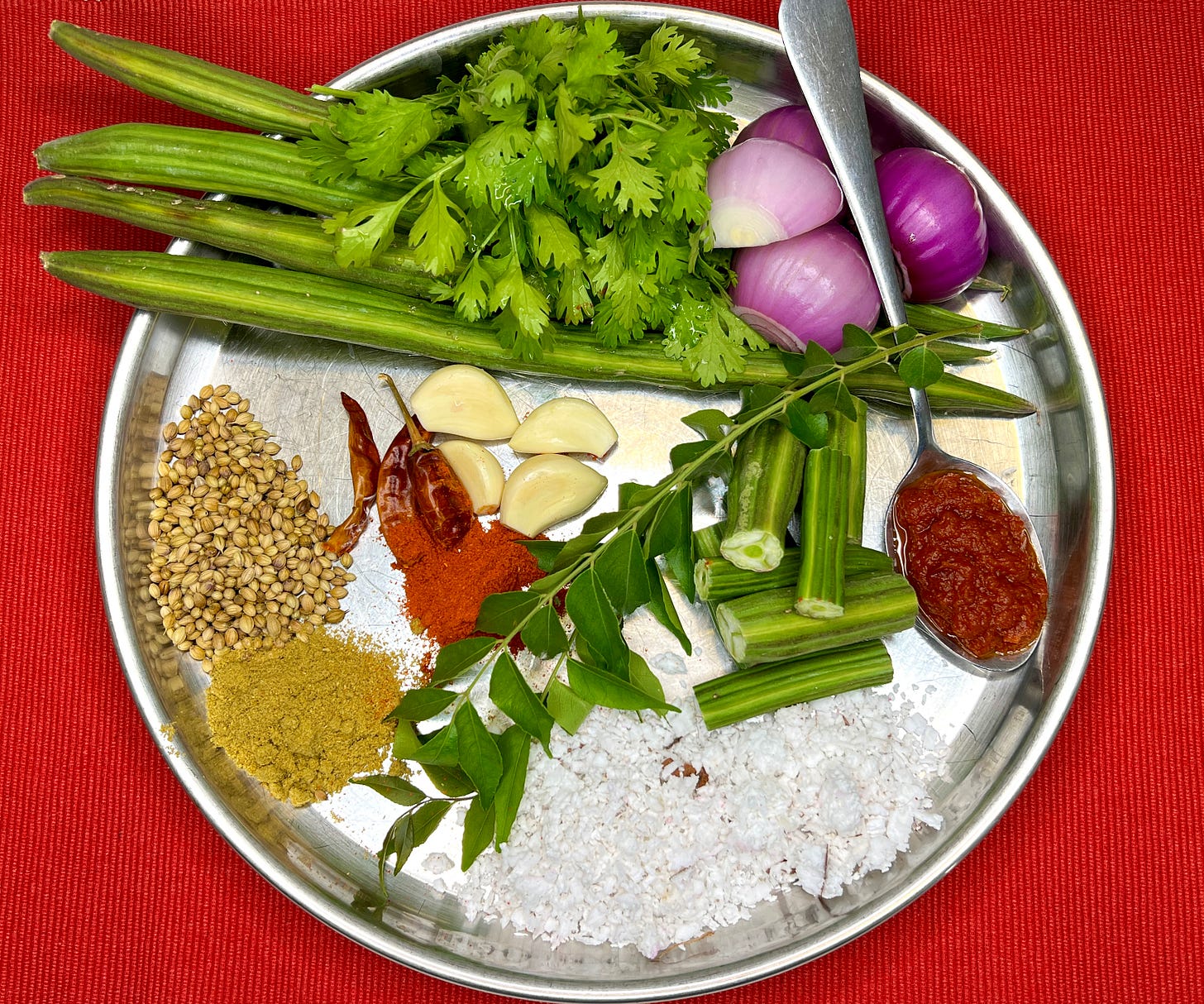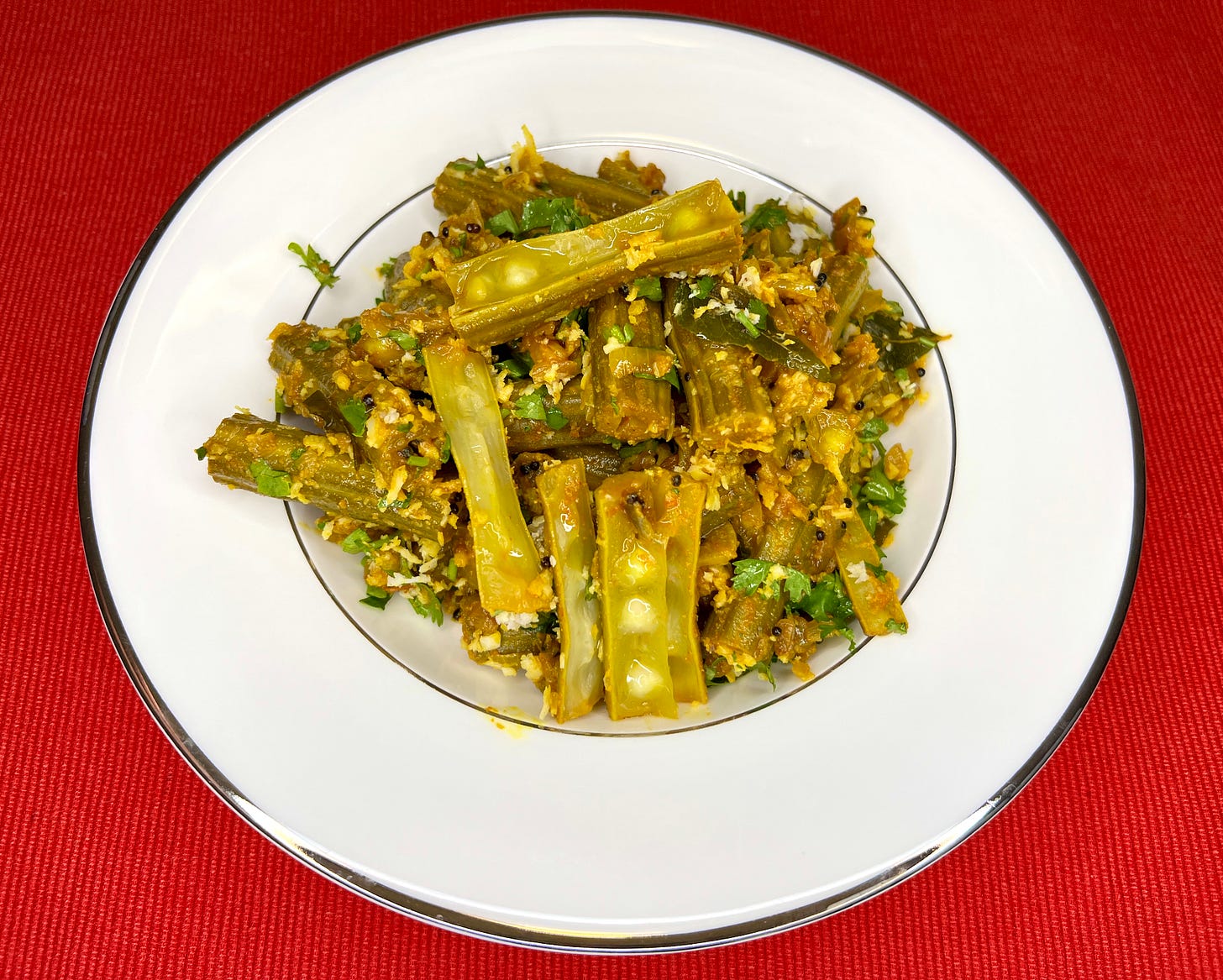Solitude
Drumstick Curry
We went camping a couple of weekends ago, with friends with kids. Three families, six children. And after a couple of years of not being able to do so, it was pure joy. In every way. And as the children were happily occupied, I had chance to go off by myself – just walking in the mountains – always within sight of the campsite simply because my sense of direction is absolutely non-existent. I mean, really. Few people actually understand how easy it is for me to get lost.
And I walked by myself for three quarters of an hour, deeply breathing in the cool air, not thinking very much, yet thinking an awful lot. About how it felt to walk by myself, with my own thoughts. About the luxury of not having to think about much save my surroundings. And then thinking about how just being able to think, or not think, was allowing me to get recentered. Refocused.
Somewhere on Jebel Akhdhar in Oman
And that took me down this particular rabbit hole. For me, the idea of getting space and time for myself is, still, not an Indian one. When I was growing up, personal time, personal space, time for ourselves was never, ever a thing. And for my parents, even today, it still isn’t. I think they are baffled at our need for time and space to ourselves – it seems to them, selfish, self-indulgent. And for years I have wondered why. Now I won’t speak for other Indians of my generation much less the younger generation (maybe this has become important for them), so I’ll speak of what I know of the older generation that raised me.
It is 2012 July. We were in India - my husband, a pregnant me, my husband’s sister and her five-year old daughter, and a close friend of mine. All in Bangalore at my parents’ house. The purpose of the trip was for my husband and me to have an Indian wedding ceremony (we’d got married in America six months earlier). And for all the others, it was their first visit to India. Throw in a wedding complete with henna, and yay!
My husband’s five-year old niece had a hard first couple of days. She’d apparently not eaten much on the flights, and once she got to Bangalore, was finding things strange enough to continue not eating anything. My sister-in-law kept her duly hydrated, and declared that the kid would eat when she was ready to. Which she did. An entire large bag of potato chips. Which she promptly threw up. Now prior to her consuming the chips, she’d worried my mum, who, in typical mum-style, told me that she was terribly worried about the kid (that worry increased ten-fold when the puking happened). I simply asked her why she was worrying when the kid’s mother clearly was not. My mum looked at me, more than slightly incredulously. That is not our culture, she said. Not Indian culture.
This is a sentiment I have heard many, many times in the almost 30 years that have elapsed since I first moved away from home. You have become too western. You have lost touch with your Indian culture.
So what, then, is this particular aspect of Indian culture? Worrying about everyone else and not yourself? Worrying about everyone else so much that it affects your own mental state? Oh, and how do you draw the line between concern and interference?Yeah…maybe we shouldn’t go there. And that’s exactly how I remember childhood. Not taking time for oneself for any reason; regarding a need for time as luxurious, and, therefore, unnecessary.
So personal space and time are clearly more important in more individualistic communities. And Indians, being more community-oriented,…well, haven’t focused much on the idea of personal space and its relationship to self-care. At least Indians of the generation I am talking about.
But here’s what I wonder.
Would my grandmothers have been happier had they had/taken space and time for themselves? I mean, from what I know and understand from stories about that generation, women simply went from performing one wifely or motherly duty to another. And before they knew it, the day was done. And I’ve mentioned in previous posts that my paternal grandmother, Paati, gave up her passion, her music, after she got married, and my maternal grandmother, Ajji, well…she never smiled - remember the picture of her and my grandad? And one generation later, I certainly don’t remember my mum (or dad, for that matter, but my dad’s an exception in more ways than one) taking time for themselves – or perhaps I just didn’t (still don’t) see it. Their days were filled with what had to be done. Now I’m most certainly not saying that everything that “had to get done” was unpleasant – far from it. But. That was just it. Things had to get done. And all the things that had to get done revolved around family and children. Which left little time for much else. Self-care?? Pshaw!
So, walking in the cool mountain air a few weeks ago, I wondered where and how they re-centered themselves, re-energized themselves. Or didn’t they need to? And if they didn’t need to, why? Or perhaps that’s where religious rituals come in - did my Ajji’s daily poojas afford her time away from the mundane? Do my mum’s? I don’t know. My feelings about religious rituals don’t allow me to view them as regenerative in any way whatsoever. And never have.
And continuing on my walk, I wondered if self-care was (is?) even a thing in India. Particularly among the older generations? Or even among the current generation in places outside large cities? The non-urban Indian? Meditation, journaling, practicing mindfulness, long walks alone, self-affirmation – my parents would just laugh. Heck, rewind 10 years and so would I have.
But here, to me, is the biggest irony. Ayurveda is rooted in self-care and strongly advocates practices that promote well-being. So what happened? Oil baths notwithstanding, I don’t remember much self-care going on with anyone when I was growing up.
Maybe those oil baths I hated did more than I thought…
What I do know is that as I have adopted what to my elders is a very western notion of personal space and time, taking that space and time, practicing self-care, also does afford me the opportunity for personal growth…of many different kinds. And I am grateful.
But it is not without conflict. Walking on those mountains, underlying these thoughts, and despite the gratitude, was a question more than slightly laced with guilt: am I wimpy for wanting time for myself? Have we, as a society at large, become increasingly self-indulgent? It is extremely easy to see how some self-care rituals have gone way extreme – remember my rant about Gooplab a few weeks ago?
But it has also become increasingly easy for me to see that if I don’t care for myself, I’m not much good for anyone, least of all, my littles.
And maybe, just maybe, if my Ajji had lived just a little differently, life for a lot of us might have been just different enough? Less baggage passed on?
I have no answers. These are but the ruminations of a somewhat conflicted mind, one trying to find a balance between taking care of myself and looking after others. Trying to reconcile what my more (western) lifestyle tells me with what my cultural and familial upbringing dictates is the way of life. Not a new conflict; one that changes as I grow older.
So here is where the west’s influence on India is, even among the older generation, I’d wager, viewed more positively. Food, or at least, a certain aspect of food trends. Fashions in food come and go, ebb and flow, and over the years, there have been plenty of Indian ingredients and foods that have been, temporarily or more long-term, been accorded “super-food” status. Take coconut oil. Turmeric. And of course, these trends are often taken to the extreme…turmeric chai lattes costing a small fortune, for example. But no need to go there. A more recent food trend is Moringa. What we have known for generations the west is now recognizing, my mum likes to say. Sure.
The Moringa tree is one that provides the Indian household with what we called drumsticks – because….well, they look like drumsticks. The fruit of the tree as well as the leaves are consumed in many different preparations in India, and are known to be super-healthy.
Moringa tree with drumsticks-a-plenty
Now my Ajji and my Paati could, undoubtedly, have waxed eloquent about the benefits of the Moringa fruit and leaves. But they didn’t. It was just understood then that what we ate was healthy; that our meals were balanced. We ate drumsticks at home pretty often, cooked in many fantastic and different ways. So today, I give you a recipe for a drumstick curry, not something we ate at home, but one I developed a few years ago.
Drumsticks are an interesting veg, as you can’t eat the fibrous exterior of the bean-shaped pod. It is the fleshy insides with the seeds that are consumed. You scrape out the insides in exactly the same way you would scrape the fleshy part off an artichoke leaf.
My drumsticks for this recipe were home-grown. Lucky me. When I was in the US, however, on numerous occasions, I used frozen drumsticks I’d buy at one of the Indian markets I’d frequent. These are great – so go ahead and buy them if you happen on some. Trust me, this drumstick curry is stupendous.
If you do have access to fresh drumsticks, fantastic. To test if they are tender, twist them, in the same way you would wring water out of fabric; they should yield. If they don’t, they are true…er… drumsticks. Sorry. Couldn’t resist.
Drumstick Curry with Fresh Coconut
Ingredients (serves 4; vegetarian; vegan)
1. About 400grams (1lb) drumsticks, cut into 1 ½ to 2 inch pieces with both ends discarded.
2. 1 ½ cups finely diced onions
3. 2 Tbsp finely chopped garlic
4. 2 Tbsp coconut oil (this tastes really good in this recipe; if you don’t have any, by all means use any neutral oil you do have)
5. ½ Tbsp mustard seeds
6. 1 Tbsp tamarind paste
7. ½ tsp turmeric
8. 2 sprigs curry leaves
9. 1 ½ tsp salt
10. 1 tsp sugar
11. ½ Tbsp ground coriander
12. 1 tsp Kashmiri chilli powder (or ½ tsp cayenne, or more if you want it spicy)
13. 1 cup fresh grated coconut or desiccated, unsweetened coconut
14. ½ cup chopped fresh coriander
Method
1. Boil the drumsticks with 1 cup water, 1 tsp salt, and 1 tsp sugar and the tamarind paste. Boil till you can easily tear the drumsticks apart at the seams. The flesh and seeds should be very tender. How long this takes depends on the thickness of your drumsticks. With mine on this particular day, the cooking took 20 minutes.
2. Heat the coconut oil in a heavy-bottomed skillet. The coconut oil has a much lower smoke-point than a vegetable oil, so watch for it smoking. When it starts smoking a bit, turn the heat down.
3. Add the mustard seeds, and allow them to pop. Once they have popped, add the turmeric, and curry leaves. Stand back if you are using fresh curry leaves.
4. Now add the onions and garlic, and ½ tsp salt. Sauté together on low-medium heat for about 10 minutes, stirring occasionally. You don’t want the onions to caramelize, but to simply turn translucent.
5. After 10 minutes, add the cooked drumsticks with any remaining water, 1 Tbsp ground coriander, 1 tsp Kashmiri chilli powder, and ½ an additional cup of water.
6. Allow all this to cook together for about 7 minutes on low-medium heat, to allow the flavors to marry and to allow a lot of the water to evaporate.
Once most of the water has evaporated, add the fresh coconut and chopped cilantro. Stir, turn off heat, and serve with a rice and dhal of your choice.






Chandrika, I definitely relate to you in this post. It is until some years ago that I started my journey into having space and time for myself. This need for self care would probably sound selfish back home where everything revolves around family and taking care about others. The woods here in Flagstaff have been my space for solitude and mindfulness and I am grateful I can grow to be a better person after each walk, hike or run. Thanks for sharing your thoughts and the recipe.
I'll add, though, that luxuries like time, room, and privacy have often been things that powerful men claim for themselves, while scorning the possibility that people who aren't powerful, or men, might also need them. Private offices kept separate from the women in the typing pool, or the wife who has to write at the kitchen table, or, in prisons, the incarcerated crowded together; private rooms in houses where women and children slept in the same bed; private and elaborate chapels in castles and monasteries, while the rabble worship on the church floor--am I wrong to think that in many cultures, powerful men have fought for and claimed these things without a smidgen of guilt? So that says to me that everyone wants or needs some room and privacy, but that maybe, if we can't have it for one reason or another (no money, no room, large families, whatever), then we tell ourselves and other people that it wasn't really necessary, we never really wanted it, and you shouldn't want it or have if I couldn't have it...or maybe even if I can. Maybe it's easier to say, "I never really needed it, and no one else does either" than "I need something desperately that I know I'm never going to have." And maybe it's easier still if one's fortunate enough to have extroversion as a baseline temperament.